Complete French Lop Rabbit Guide: Housing, Common Traits, Cost, And More
The French Lop rabbit breed is the gentle giant of the lop breeds and is definitely in the top 5 largest rabbit breeds when it comes to overall body size, weight, and length.
There really isn’t a breed like them. With their large head, thickset body, and being a novelty when it comes to their large size, it makes them a great pet rabbit.
While small kids can’t move them on their own they are great of sitting next to them and being petted. I will get into this later but like any rabbit, they still prefer a calm environment.
This breed is larger than the average rabbit but if you are prepared and willing to be confident when handling them you will be prepared to raise a happy and healthy French Lop after you read this complete French Lop guide.
Overview of what is covered in this post:
- Important facts you need to know about a french lop such as size and lifespan.
- Tips on feeding, grooming, and housing.
- Coat type, recognized colors, the breed standard.
French Lop Breed History
Believed to have been bred using an English Lop and a French Butterfly rabbit, the French Lop was mostly used as a meat animal when it was first bred in France around 1850. Yep, they are technically a meat rabbit.
This rabbit rose in popularity in neighboring European countries such as the Netherlands, Belgium and even Germany. In 1933, it was reported that approximately 10 French Lops were brought over from the Netherlands and exhibited in the United Kingdom, although it wasn’t until the 60’s that they became popular in the UK. Finally, these rabbits made their way overseas to the United States circa 1970-1971.
The French Lop is a large breed of rabbit that makes for a wonderful pet, due to their calm, docile temperament.
While this giant breed is actually a meat rabbit they have lost their standing, especially in the U.S. because they take much longer to mature than other meat rabbit breeds and have huge bone mass.

How Big Does A French Lop Get
So let’s start with the obvious. The size. Next to the flemish giant rabbit they are one of the largest breeds with a very large body mass.
In the US French Lops weigh a minimum of 11 pounds for bucks (male) and 11.5 pounds for does (female) On average the French lop can have a body length of up to 30 inches from toe to nose.
Groth by Months Of Age:
- A french lop rabbit baby that is 12 weeks old or less should weigh on average 3-5 pounds
- 3-6 months they should get to be about 8-10 pounds.
- After that, they slow down quite a bit but will grow until they are 12-14 months filling out and get slightly more stocky until they reach maturity.
You can read more about the french lop size and comparison here in this post.

If someone tells you their French Lop weighs 20+ pounds…. yeah don’t believe it unless you saw the rabbit on the scale yourself. Rabbit owners are like dog owners in the sense that they like to exaggerate juuuust a touch on how much their rabbit weighs.
In the show world the bigger the better when it comes to French Lops. BUT don’t mistake size for good body confirmation.
Weight is hard to “eyeball” with rabbits and when you are raising them it is really important that you know what they weigh especially if you raise a show rabbit or want to make sure your rabbits are good quality.
Knowing the weights is also something that will help you know if you are getting screwed over. If someone says they have a french lop but it only weighs 8 or 9 pounds it is either a really big mini lop or is a mix.
On the flip side if you are thinking that a French lop is too big for you check out a Holland lop. Here is the size comparison post where I look at a French lop vs a Holland lop size.

French Lop Rabbit ARBA Standard
The ARBA breed standard for the french lop is that it weighs 11 lbs or more for bucks (male) and 11.5 lbs for a doe (female) with no maximum weight. This is why you will see a wide range of wights for these guys.
With that said you will see on average 12-13 pounds for the breed occasionally up to 15lbs in the US. If you hear someone say their rabbit weighs more than that I would be skeptical and only believe it if you weighed them yourself.
How Old Does A French Lop Live To Be?
A french lop will live to be about 5-7 years old. Think of it like dogs. The bigger the dog breeds the fewer years they live.

Feeding A French Lop
How Often To Feed A French Lop.
First off I only feed my rabbits once a day (also around the same time every day if possible) and here’s why. When rabbits get sick loss of appetite is the first sign they are not feeling well. So if you feed your rabbit the same time every day you will be able to tell if they haven’t eaten as much as they should have.
Then you can check them over to see if something is wrong.
Rabbit Feed Formula
Rabbits need to have 16-18% protein and about 22% fiber. FIBER DOES NOT MEAN HAY!!! I have some strong beliefs about this and it’s a hill I will die on. Commercial rabbit pellets have the exact nutrition that growing and adult French Lop rabbits need.
Read this post to find out why I don’t feed my rabbits hay.
Rabbit food in pet stores is not a proper diet. They are often 12% protein which is significantly less than a rabbit should have. This will cause all kinds of health and weight gain issues as well as reproduction issues.
If you are feeding a commercial brand of rabbit pellets that is all your rabbit needs on a daily basis. They are designed to be a full rabbit ration. Adding all of these fresh vegetables and leafy greens may sound like a good idea but that is not a full diet with everything they need.
A full-grown French Lop rabbit should eat 4.5 lbs of pellets per week or about 1-1.5 cups of pellets a day give or take. That is if your rabbit is eating a pellet-only diet.
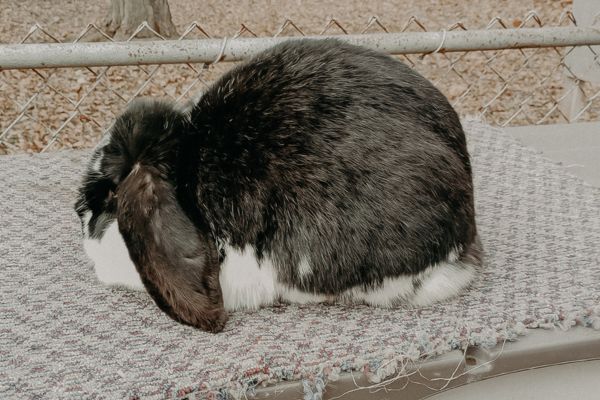
Be Very Spiratic With Treats
Veggies and fruit should be treated as treats, not requirements. Rabbits can lock in on one specific thing they want to eat and decide to ONLY eat that one thing. Fruits and vegetables only have 3% or less protein. Your rabbit will lose muscle mass if they eat only vegetables.
If you want to give your rabbit treats it should be so spirtac the rabbit can’t tell when you will give them the treats. — About once a week to every two weeks is going to work best.
Give the rabbit time to eat their pellets first before offering treats like bananas or carrots.
French Lop Housing
While I do not think keeping house rabbits is the best choice for the rabbit’s health I realize we are in a world where people keep rabbits indoors. So I am going to cover some basic information about keeping a french lop indoors and outdoors.
Why Keeping Rabbits Inside Is Dangerous
Houses are a danger zone full of things that if ingested will kill them. Fabrics, sainted or painted wood, carpet, drywall, and many other things that are just waiting for your rabbit to sink their teeth into. You may think “I’ll be careful” but I can not tell you how many people I have had come to me and say those exact words but their rabbit got into something and it got a bowl blockage or intestinal issues and died.
I used to beat around the bush about these things but so many people are not taking it seriously I have decided it’s worth saving people from heartache rather than trying to be nice about it.
The best way to combat this is to NOT let your rabbit have free range time around your house. You wouldn’t leave a baby unattended so why is it ok to let animals go wherever they please?
This Is The Best Set Up To Keep A Rabbit In Your House If You Choose To Do It
If you are dead set on keeping your rabbit inside you need to keep the rabbit in a pen or cage without sold floors (more on that later) when you are not with them. DO NOT let them loose in a room.
Then when you are able to pay attention to them fully you can get them out and then put them back.
Tips For Keeping A French Lop Outside
If you are going to keep a French Lop outside here is what you need to do.
Here is an example of what my outdoor rabbit housing setup looks like.

Keep the hutch in the shade at all times. Rabbits are very sensitive to heat and if they get in direct sunlight, especially in the summer it could be detrimental.
Make sure the rabbit has good airflow. Rabbits especially French Lops can be prone to respiratory illness. This also helps them stay cool during the summer.
Keep your rabbit off the ground. There are so many diseases that can be brought to your yard by wildlife that can harm your rabbit very quickly. Even your home in the city is not exempt.
French Lop Cage Size
The ideal size for a French Lop cage is 30W×30D-40×20H these are hard to find for indoor cages because French Lops are not your most common rabbit breed for a family pet.
You can take the 30 by 30 inches of space and smush that around to fit your space but the height is important because they do sit up on their hind legs like a dog sits. Making them quite tall. Most cages for rabbits need to be adjusted or you may have to find something for a dog to make it work.
Water’ers
French lops need LOTS of fresh water. These buggers pee more than my miniature dachshunds.
I LOVE these water bowls and I wish I had started using them sooner. They are perfect for the large breeds to have enough water during the summer months and they are flexible enough to be able to pop the ice out of them in the winter without breaking the bowl.
Bottles are fine as well but honestly, I think they are a waste of money because of how badly they can leak. In the summer heat with a large rabbit, you DO NOT want to run out of water.
Best Feeders For French Lops
Ideally, you need a heavy bowl or something that can be locked down so the rabbit can’t throw it around and waste the feed. Which can be hard to find.
- Ware Manufacturing Plastic Slide-N-Lock Crock Pet Bowl for Small Pets, 20 Ounce – See On Amazon
- Pet Lodge Steel Small Animal Feeder with Lid Small Animal Feed Box – See On Amazon
These are a typical rabbit feeder BUT these are designed to have a hole cut through the cage wall and stuck through from the outside. I didn’t want to do that to my cages so I took the hooks and bent them backward and it works just as well. I can attach that feed trough to the inside of the cage.
Free Farm Goal Planner!!!
➡️Get my proven system for choosing your farm goals so you don’t get burnt out.
How much does a french lop cost
On average, you can expect to pay around $75 to $150 for a French lop. However, there are a few factors that could affect the price.
The price of a French lop can vary depending on factors like the rabbit’s age, color, and pedigree.
Younger rabbits tend to be more expensive than older ones, and certain rare or unique colors can also drive up the price.
Additionally, French lops from champion bloodlines or with show potential may come with a higher price tag. Where you purchase your French lop from, such as a reputable breeder or a pet store, can also impact the cost.

Upkeep Costs
Maintaining a happy and healthy French lop rabbit doesn’t have to break the bank! Let’s break down the costs to give you a clear picture.
Cost Of Feed
Like I said before commercial rabbit pellets are going to be the best thing you can feed your rabbits. A french lop will go through a 50-pound bag about every 10 weeks. Feed expenses for a French lop rabbit can vary depending on the brand and type of food, but budgeting around $20 every two months is a good estimate if you plan to give them treats as well.
Bedding Costs
If you keep your rabbit outside in a hutch the waste should fall to the ground for the best health situation for the rabbit. So in that case it would be $0
But if your rabbit’s hutch uses a tray you will likely have to change the tray every 5 days or so. A bail of pine shavings costs about $6 I would budget for using one a month.
Toys should be made from free things around your house. Buying rabbit toys again is dangerous because rabbits are going to chew them up and possibly ingest pieces from those toys which is really unhealthy.
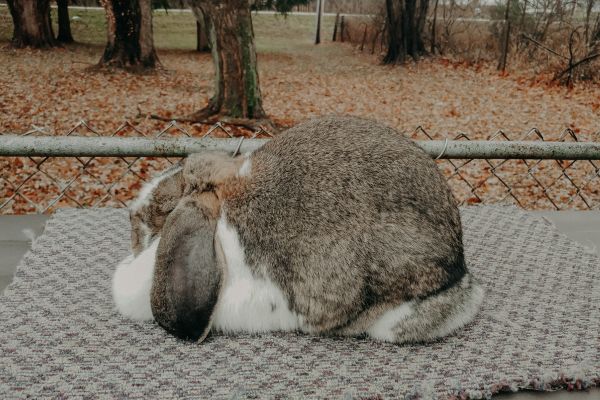
Taking Your Rabbit To The Vet
Unpopular opinion alert. Your rabbit is not equal to humans, you are not obligated to take your rabbit to the vet. Do not feel bad about not taking your rabbit to the vet for every little thing.
Because I have found that vets are not all that good about knowing what’s wrong with a rabbit. And most things that will go wrong with a rabbit you can fix yourself.
A simple visit to the vet starts at $50-$100.
Ready To Get A French Lop?
Check out our rabbitry and see if we have any available or get on the waiting list for more choices to choose from. I’ve been raising french lops since 2009 and do my best to raise rabbits that meet the ARBA standard and have good temperaments that make great pets.
Pros & Cons of Keeping a French Lop Rabbit as a Pet
Let’s talk about the pros and cons of keeping these large rabbits as pets.
- On the plus side, French Lop Rabbits are known for their personable nature and love for attention and head rubs. They have a great personality and can be quite affectionate.
- But a french lop is a powerful animal and when they don’t get their way they can be quite determined. This is why it’s important to have clear boundaries with your rabbits and if you don’t want to let them lose in your house… Don’t do it even once. If you need to move them from one space or another you need to be strong and confident. Not timid and shy.
- French lops are easy to keep up with as far as grooming. Unless they are molting they need very little bushing. They do need to have their nails trimmed about every 6 weeks.
- French lops are very forgiving when it comes to learning how to handle a giant rabbit.
- French lops prefer to sit with you and be petted for human interaction vs being carried. In fact, most rabbits are best this way.
- They are a bit sensitive when it comes to digestion and health issues so make sure to keep it consistent and don’t change things up too much.

Common Health Problems
French Lop rabbits may experience a few common health problems that you should keep an eye out for. These include dental issues, gastrointestinal stasis, weepy eye, ear mites, wool block, and joint or heart issues due to their larger size.
Dental issues can be spotted if your bunny is having difficulty eating or has drooling. Gastrointestinal stasis, also known as GI stasis, shows through symptoms like decreased appetite, bloating, and constipation.
If your rabbit is showing signs of shaking its head, scratching its ears, or having crusty formations in its ears, it may have ear mites.
Woolblock, where hair collects in the digestive system, can lead to reduced appetite, runny stool, and act lethargic.
Lastly, joint or heart issues may be noticeable if your French Lop is having trouble moving around or breathing.
To keep your bun in tiptop shape, make sure to schedule regular check-ups with a bunny-savvy vet, provide a healthy diet with lots of fiber, and give them plenty of space to exercise. By keeping an eye out for these symptoms and taking preventive measures, you can ensure your French Lop rabbit stays happy and healthy.
Weepy Eye
This breed can struggle with weepy eyes. While a little discharge is normal the breed can have it get pretty bad. If the polin is high or if you live in a farming community rabbits can have seasonal allergies like humans do. Causing the eyes to weep. This isn’t that bad in itself but where it causes a problem is when it turns to build up and the rabbits get thick eye dirt built up around their eye and it can cause an eye infection.
My Rabbitry Must Haves
Eye Lashes Curling
French lops have long eyelashes and having a big bold face sometimes the skin around the eye may curl in. There are some cases where eyelids (mainly in bucks) can roll in towards the eye. This should not be bred into a herd if you can help it. The eyelashes can rub on the eye and you might have to keep them trimmed to help with the eye irritation. Sometimes getting the eye to calm down and reduce swelling will be enough for the rubbing to stop. But it may not.
Unfortunately, this does not tend to show up until they are about 10-12 months of age. There are some breeders that will keep a rabbit that has great body type but has really bad eye issues. Making it hard for those who want to cut that out of their herd.
If you have to work on a rabbit’s eye you should do it for 10-15 minutes at a time and for multiple days in a row. Don’t spend hours aggravating the eye. You could cause enough irritation to keep the weepy eye going.
Touchy Digestive Tract
French lops are VERY touchy when it comes to eating. I do not feed my rabbits hay. It is too dangerous with the hay getting wet and moldy. You may not even see it but it’s there. You can read more about that here.

French Lop Rabbit Personality
They are VERY laid back and I think because of the size not much scares them so they rarely are stressed out. I have been bitten MAYBE 3 times in my whole career raising french lops. And the times I can think of I had it coming.
They are a very lazy breed once they mature around 12 months old or even 14 months depending on the lines they come from.
They are super sweet animals, even the does (female rabbit) should have a good temperament. — If they are aggressive all the time they should not be bred.
Reasons They May Be A Bit Grumpy And When It’s Ok
The only time I give a little leeway is if a doe needs to be bred. But that is normal for any breed. OR if we are traveling and not somewhere they are used to. They may act fussy but should still never bite even when they are frustrated.
They will still need their quiet time alone even though they are pretty social animals. Too much will overwhelm them. So if they are acting stressed back down and give them their space.
I had a doe named Evelyn and she was an exception to the rule. Even when she is ready for babies she is not grouchy at all. But there are a few who just want to be left alone or jump back and grumble when you go to pet them. In that case, I give them their space and pet them when they want it.
If you notice a sudden change in your rabbit’s behavior like they are holding their head in the corner of the cage. Or the rabbit is avoiding you when they usually don’t. You should check them over to make sure nothing is wrong. They likely are not feeling well.
French Lop Grooming
Just like us humans, rabbits need regular grooming to stay healthy and happy. Not only does grooming help keep their coat clean and tangle-free, but it also gives you a chance to bond with your rabbit and check for any health issues. So, let’s dive into rabbit grooming and learn how to keep your rabbits clean and looking great.
Brushing
A simple wire-toothed comb is just fine for checking for tangles or debris in the fur. If the rabbit is molting I love using this type of comb with two different lengths of teeth. It works great for getting dead fur off of your rabbit.
Shedding Vs Molting
Shedding is the daily, gradual loss of fur that occurs as part of a rabbit’s natural grooming process. On the other hand, molting is more dramatic when rabbits shed their old coat and grow new ones, which usually happens once maybe twice a year.
The image below is of a french lop buck that was molting.

When it comes to French lop rabbits, they tend to experience shedding and molting just like any other rabbit. However, their major molts typically happen in the summer and late fall. During these times, you might notice a lot more fur coming off your French lop than usual.
So, how can you tell the difference between shedding and molting? Well, shedding is a continuous process and you’ll see some loose fur when you pet your rabbit.
Molting, on the other hand, involves a larger amount of fur loss and you might even see patches of bare flakey skin on your bunny. There can even be mood changes during molting. It’s not uncommon for rabbits to get pretty grumpy until the molting process is complete. But don’t freak out or immediately rush to the vet.
Should French Lops Get Baths
The short answer is no!!!!
French Lops (or any rabbit for that matter) should not be given baths. Baths can cause a complete shock to their system.
If your bunny gets into something messy, a spot-cleaning with a damp cloth or scent-free baby wipes is the way to go.
If your rabbit has caked on poo due to illness or living in a cage with a solid floor (which is why I do not encourage litter boxes where the rabbits can sit in the box) you should try to just cut the fir off first. It will grow back. Then if that is not going to work you can use a small amount of water only as a last resort.
Coat Type
This rabbit’s rollback coat is dense, short, and soft.
Because it isn’t very long, their coat is not appropriate to spin in order to make wool, but they do shed more in particular seasons. During off-season shedding times, one brushing a week with a bristled brush should be sufficient
When the height of summer and when it is the warmest. French lop rabbits will need to be brushed more often. They will molt when the temperatures get very high or right at the end of summer with the sun is pretty strong. You will have to increase their brushings to twice or three times a week (if necessary).
When a french lop rabbit is molting I find that “plucking” helps get the larger chunks of hair that are coming off and stuck in the undercoat. It will hurt less than sticking a comb in their coat and forcing it out.
You basically grab onto the fur that is fluffy and looks like it is standing above the rabbit’s normal fur length and pull it out like cotton candy. It will come off very easily.
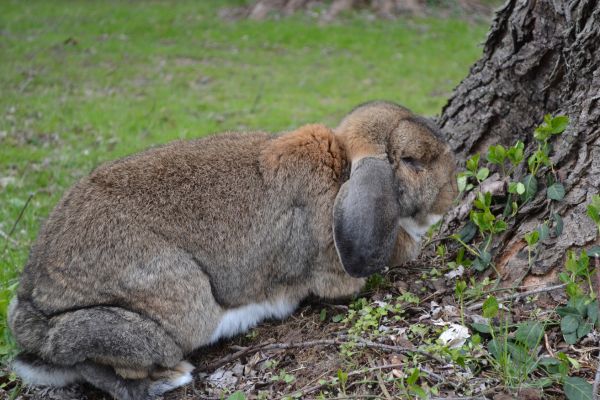
French Lop Rabbit Colors
The french lop has a wide variety of colors.
The American Rabbit Breeders Association has a set of recognized colors for the french lop that are categorized in different groups. There may be some other colors that you see by simply scrolling the internet but that does not mean they are a part of the breed standard.
I am going to share as many pictures as I can of the colors I have.
French Lop Broken Pattern
If a rabbit has white on it (as shown below) with coloring on its back then it is known as a broken pattern. ALL of the colors could come in a broken pattern ( except for Ruby Eyed Whites. This doesn’t change the name of the color itself.
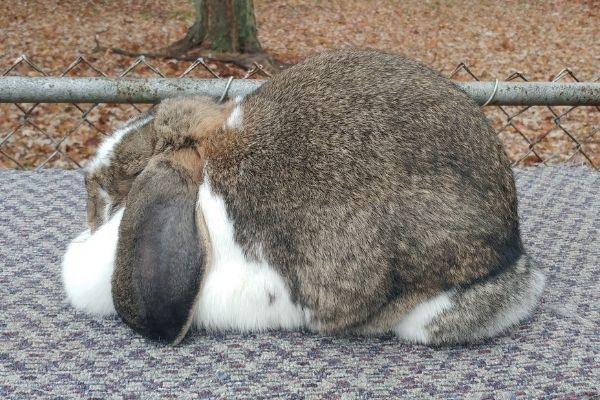
French Lop Rabbit – Agouti Color Group
- Chinchilla (Base Colors:Black, Blue, Chocolate, Lilac, Sable, Or smoked Pearl
- Chestnut (Base Colors: Black or Chocolate)
- Lynx
- Opal
- Black
- Blue
- Chocolate
- Lilac
- White (Blue or Red Eyes also known as BEW or REW)
Agouti French lop colors

Black Chinchilla French Lop Rabbits
The chinchilla color is a salt and pepper look. The solid rabbits will have light underbelly with far less color.

Solid Chestnut French Lop
A chestnut rabbit looks just like the wild rabbit markings. They will have the color on top and a light-colored underside.
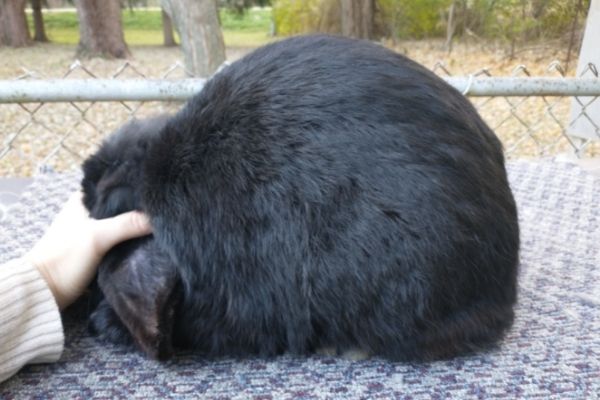
Black French Lop
A black rabbit should not have any other colors on them at all. If a french lop has even the slightest amount of color over its shoulders (often in a light brown color) It is a steel. Meaning it has tipping on the ends of its fur.
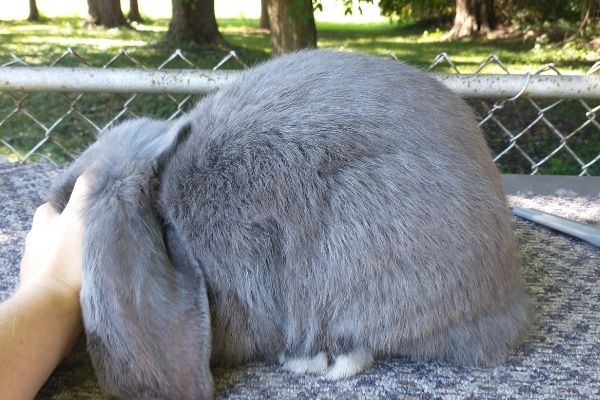
Blue French Lop
A blue french lop rabbit is often mistaken for gray. It should not have any other color on it. Its feet and underside should also be solid blue.
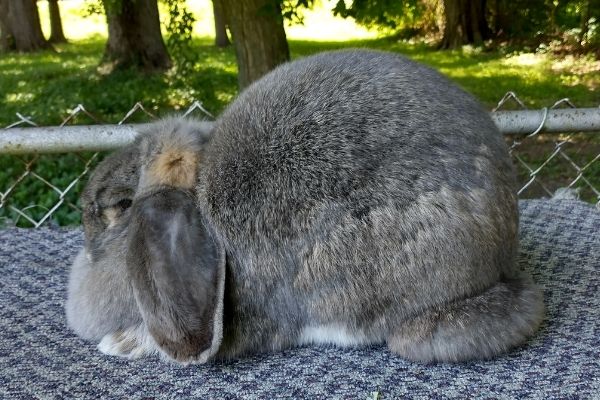
Opal French Lop
This doe is going into molt so the light that you see across her midsection where her hair looks different is just her changing coat…. Opal appears blue-gray as the overall color. Opals have very light tan around their eyes and on their crown. They will also have light feet and a light underbelly.
French Lop Rabbit – Shaded Color Group
This group of colors is far more rare to find.
- Frosted Pearl (Base Colors: Black, Blue, Chocolate, Lilac)
- Sable
- Sable Point
- Seal
- Smoke Pearl
- Tortise
Shaded French Lop Colors

Black Tortoise
This coloring is very rich and deep. The rabbit looks like a deep red color while the nose, ears, and underside are shaded with black.

Blue Frosted Pearl
This color looks mostly which except they have a light shading around the nose, ears, feet, and rump.
French Lop Rabbit – Ticked Color Group
- Silver Fox (Base Colors: Back, Blue, Brown, or Fawn)
- Steel – Gold or Silver Tipping (Base Colors: Black, Blue, Chocolate, Lilac, Sable, Smoked Pearl)
- Cream
- Fawn
- Orange
- Red
Ticked French Lop Colors
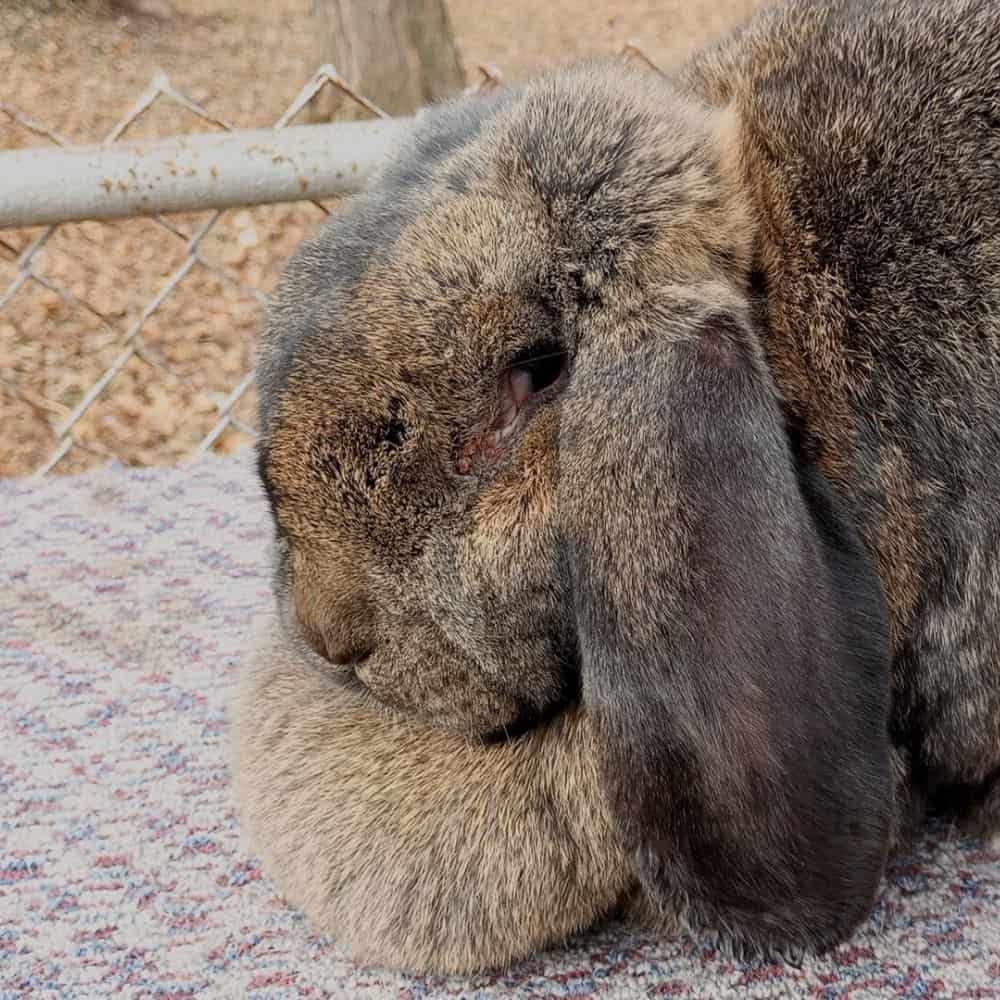
Black Steel – (Gold Tipped)
Anya is a gold-tipped steel that is VERY heavily tipped but you can have them lightly tipped that you can hardly tell they are tipped. The coloring is on the ends of the fur and does not go all the way down to the skin like the chestnuts.
You can have black steel where the base coat is black. OR there are blue steels where the base color is blue (grayish color)

Fawn
This is a much lighter and yellowish color. The belly, underside of the feet, and tail will be light to almost white.
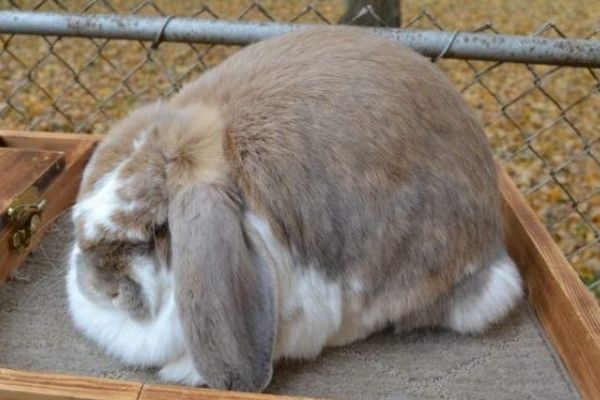
Cream
This color is almost a blueish blond-looking color. With shading blue shading around the ears, nose, and underside.
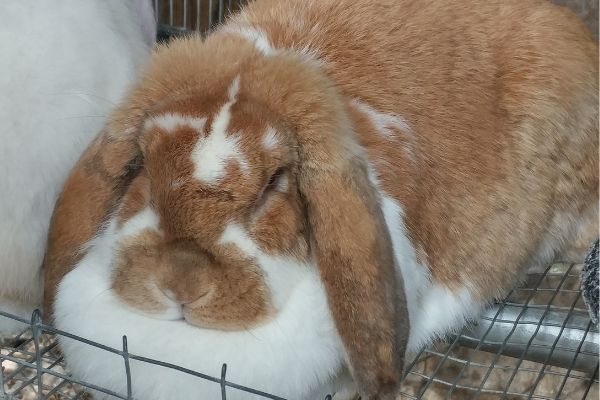
Orange French Lop
This color is often confused with a fawn. Orange rabbits are VERY BRIGHT and a richer red color than a fawn
Exercise
French lops are natural couch potatoes. While being completely stagnant isn’t healthy. If you have a large enough pen they can move around in you won’t have to worry about getting them out to “exercise” every day.
When it comes to creating an exercise routine, it’s all about making it fun and interactive. Try setting aside 30 minutes to get your french lop out and interacting with it you are good to go. And here’s the best part – get the whole family involved! Not only will this help the rabbit bond with everyone, but it also ensures that they get the attention and interaction they need.
You can also give the rabbit things to through around and that will give them plenty to do. Make sure it is made of VERY HARD material so the rabbit can’t chew it up. Something like old spoons or old feeders are great for letting your rabbit use them as a toy.
Training Your Rabbit
Let me first be clear you are not going to train your rabbit like a dog. Rabbits learn best by simple repetition over a long period of time. Not treats or long training sessions.
Not matter what ALWAYs end on a good note. If you see the rabbit is starting to get frustrated or scatterbrained, stop and do it again tomorrow. Rabbits are very short-sighted and will remember the scary or bad over the “good times” of training.
Leash Training
First off, rabbits don’t walk on a leash like dogs do. Leash training for rabbits is more about containment rather than actually “walking” them like you would a dog.
When it comes to leash training your French lop rabbit, it’s essential to use a harness that’s designed for their size. This is crucial for their comfort and safety. And don’t forget the verbal coaxing and treats! With some gentle encouragement and yummy treats, your bunny will start to associate the harness with positive experiences.
Start by getting your rabbit used to the harness. Let them sniff it and maybe even give them a treat while you gently place it on them. Let them just learn to have that on for a while.
Then, attach the leash and let them wander around while you hold the other end. Encourage them with your voice and treats to come towards you, slowly and steadily.
Remember, patience is key! With some time and lots of positive reinforcement, your French lop rabbit will eventually get the hang of leash training.
French Lop Rabbit FAQs
Are french lop bunnies good pets
French lop bunnies are some of the best pets you could ask for! These gentle and friendly creatures are perfect for anyone looking for a furry friend to bring into their home. Not only are they cuddly and lovable, but they are also quite adaptable to various living conditions, making them a great choice for both indoor and outdoor living arrangements.
One of the best things about French lop bunnies is their gentle nature. They are known for being calm, affectionate, and easy to handle, making them perfect for families with children.
How big will a french lop get
On average, a fully grown French Lop can weigh anywhere from 11 to 15 pounds, with males being a bit smaller than females.
Interestingly, French Lop rabbits in the US tend to be a bit bigger than their counterparts in the UK due to differences in breed standards. So if you’re in the US, you can expect your French Lop to be on the larger side!
Do french lop rabbits like to be held?
When it comes to handling, they would rather sit next to you and be petted rather than be picked up. This is mainly because of their large size and fear of being dropped.
If you want to bond with a French Lop rabbit, it’s best to respect their preferences and avoid picking them up unless absolutely necessary. Instead, spend some quality time sitting with them, petting and talking to them. This will help them feel more at ease and allow for a stronger bond to develop between you and your furry friend.
Personally, I think french lops are probably the breed of rabbits. They are easygoing and don’t hate being around small children. If you want a larger size rabbit and you are willing to learn the proper care and handling they are a great breed even if it is your first time with a rabbit.
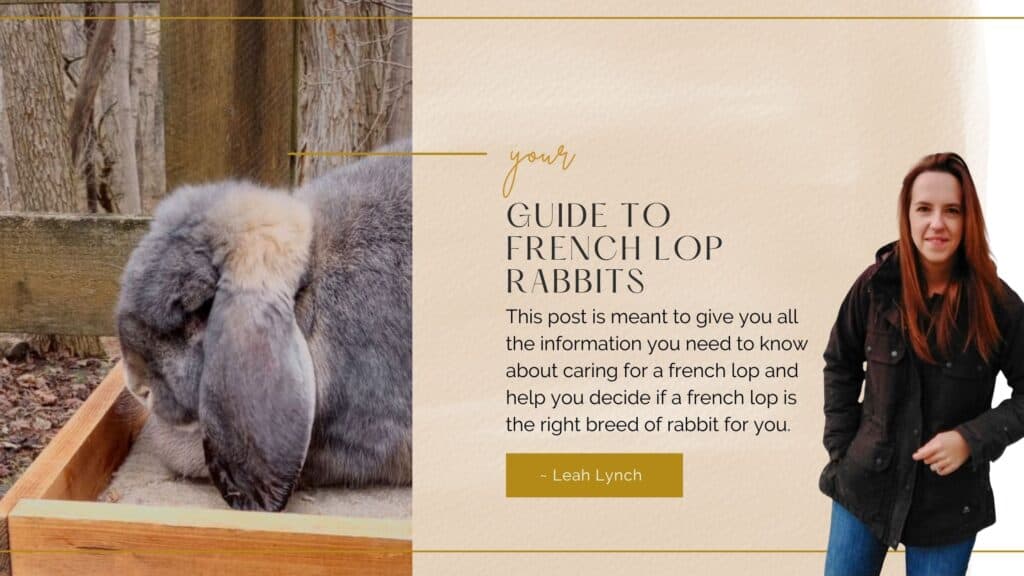
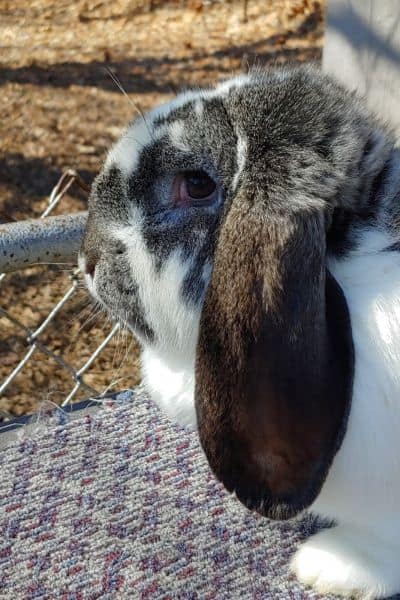
![Rabbits Do NOT Need A Companion Rabbit [here’s why]](https://leah-lynch.com/wp-content/uploads/blog-post-header-31-768x1152.jpg)


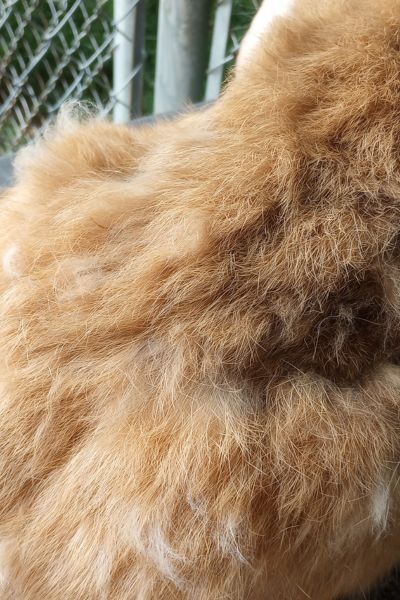
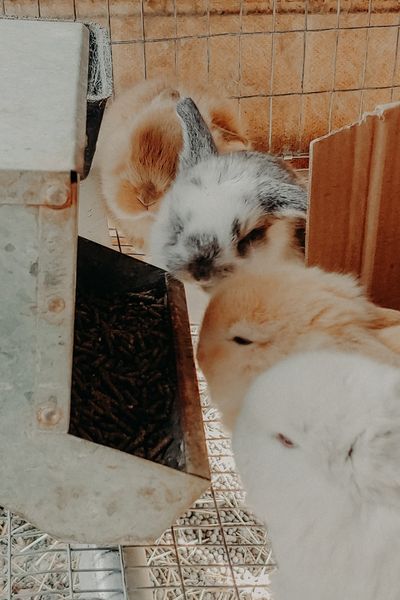
I love French lops and this article DEFINITELY describes them well. My last frenchy lived 8 years and was a Great COMPANION. I love the breed and haven’t FOUND any Other breed by that compaRes.
They are an awesome breed. I don’t think there is a breed that compares either.
You don’t feed hay because it gets wet and goes mouldy?
That’s ridiculous. Why put hay in a place it can get wet and then leave it there long enough to get mouldy to start with then!?? Don’t even dare tell me it gets mouldy fast, it doesn’t, it has to be left for a while.
It’s the single most important element to their gut!!!
No wonder you claim French lops have gut issues, its actually only your rabbits having gut issues, because there’s no hay for them to regulate their gut process!!
Also wire bottom cages are trash and can cause serious issues. Maybe just clean your rabbits out in a decent space regularly.
First lovingly put question. Why put it in a place that gets molding? – If you have a barn or garage that doesn’t draw damp or can keep out the humidity in the air let me know. Hay will pull the moisture in from the air and the inner part of the bale become moldy.
As far as the single most important element to their gut…. meaaah I disagree. FIBER is the key and if you think about wild rabbits they don’t eat just grasses. They eat all kinds of different things. Commercial rabbit feed takes this into consideration and keeps fiber at a very high percentage. If your feed from some pet store isn’t doing the job take it up with them.
As far as wire cages being an issue they are way healthier for them than sitting on their pee for even 30 minutes. A solid floor keeps them close to the ammonia in the waste breathing it in which can cause respiratory issues. And if you think someone should be able to clean a cage every 30minuts… then my challenge to you is to get a life, family, and real job then we will talk about who has time for what.